N.E.A. - Acronym for both the National Education Association (NEA) and the National Endowment for the Arts (NEA) in the USA.
necking - A cylinder at the bottom of the Greek Ionic capital between the echinus and the flutes that masks the junction of capital and shaft.
Example:
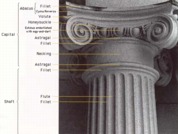
Ionic
capital and shaft, with each of its parts labeled, including
the necking.
Also see architecture and Greek art.
necropolis - A large burial area; literally, a city of the dead.
(pr. nə-KRAH-pə-ləs)
Also see Egyptian art and sarcophagus.
needle - See burin.
needle file - A thin, pointed jeweler's file.
Also see jewelry.
negative - An image produced in a photographic emulsion on a sheet of film, paper or glass by exposure to light and to development in photosensitive chemicals. This process reverses all values and colors of light and dark areas of the image to which the emulsion was originally exposed, light areas appearing dark (opaque) and shadows appearing light (transparent). Negative is the opposite of positive, especially when positive represents the values and colors of an image much as they would appear in reality. Negative can also be a synonym for "no," and as in judgment, can signify disapproval.
Example of the first sense:
![]()

Negative version
(of the positive, below)
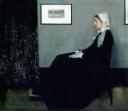
Positive
image of:
James Abbott McNeill Whistler (American, 1834-1903), Arrangement in Grey and Black No. 1: Portrait of the Artist's Mother, 1871, oil on canvas, 4 feet 8 3/4 x 5 feet 3 3/4 inches, Musée d'Orsay, Paris, France. Also see aestheticism, arrangement, art for art's sake, portrait, and rectangle.

John Shaw Smith (Irish, 1811-1873), Nile, c. 1851-52, calotype negative, 17.6 X 22.7 cm, George Eastman House, Rochester, NY. The calotype was the first photographic process to employ a negative to produce a positive image on paper. This process was patented in 1840 by William H.F. Talbot (English, 1800-1877). The earlier daguerreotype process employed no negative.
Quote:
Also see art criticism, bad art, blot, invert, and ugly.
negative space - Empty space in an artwork, a void.
That's the usual definition.
To some people, this term suggests unpleasant things. Sometimes when we say "negative" we mean "bad."
Both "space" and "emptiness" suggest a lack, a shortage of something. This is unfortunate. The concept of negative space is one that deserves to be highly prized. In Japanese art tradition, what we call negative space is called ma. Relevant in every Japanese art form, from sumi-e to ikebana, ma is considered a particularly valuable sort of space, not seen as negative or empty.
Examples:

Henry Moore (English, 1898-1986), sculpture, bronze, Art Gallery of Ontario, Toronto,
Canada. See English art.

Dame Barbara Hepworth (English, 1903-1975),
Two Figures (Menhirs), 1964, slate,
82.5 x 63.8 x 32.0 cm, Tate Gallery, London. See feminism
and feminist art and menhir.
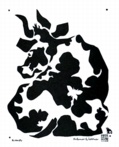
Schomer Lichtner (American, 1905-2006), Butterfly, 1975, serigraph. The shape of a white butterfly is in a negative space. Look between areas of black fur. Living in Wisconsin, Lichtner was reknowned for paintings of ballerinas and dairy cows and his regionalist murals. See acrylic paints and New Deal art.

Orange shapes
occupy positive spaces in
this image, and negative spaces
between the orange shapes form triangles, or a six-pointed star.

Negative space between violet shapes (the
positive spaces) forms a square.

Negative spaces within and between circular
green shapes (positive spaces) reinforce the linear edges forming
the sides of a cube.
Quote:
Related links:
Also see lacuna, nothing, nothingness, positive, and positive space.
N.E.H. - Acronym for the National Endowment for the Humanities (NEH) in the USA.
neoclassicism or Neoclassicism
neo-Dada - See Pop Art.
Neo-Expressionism - Broadly used, this may refer to all expressionist art since the original movement known as Expressionism arose in Germany between 1905 and 1925. Abstract Expressionism is an example of a movement which may be referred to as neo-expressionist. Neo-expressionist art stems from Wassily Kandinsky (Russian-German, 1866-1944), its antithesis from the Neo-Plasticism of Piet Mondrian (Dutch, 1872-1944). Used more narrowly, this term sometimes refers specifically to the primarily German and Italian expressionist art revival of the 1970s and early 1980s. Rejecting both conceptual and minimalist modes, these neo-expressionists returned to gestural, figurative painting. Often steeped in the German history, paintings by A.R.Penck (1939-) and Anselm Kiefer (1945-) are full of symbolism referring to issues repressed by Germans.
Examples:

Georg Baselitz (German, 1938-), Rebel, 1965, oil
on canvas, 162.7 x 130.2 cm,
Tate Modern, London. This is Baselitz's depiction of the wounded
anti-hero of today. See German art.
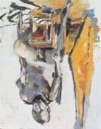
Georg Baselitz, Male Nude, 1975, oil and charcoal on canvas, 78 3/4 x 63 3/4 inches (200 x 161.9 cm), North Carolina Art Museum, Raleigh. Baselitz paints subjects inverted in order to emphasize his painting's abstract qualities. He has said, "An object painted upside down is suitable for painting because it is unsuitable as an object." See nude and object.
![]()
Georg Baselitz, Untitled, 1982-3, painted wood
(lime), 250.0 x 73.0 x 59.0 cm, Tate Modern, London. The rough
surfaces of earlier German
Expressionism can be seen
in this partially chainsawed sculpture
carved from a tree trunk.

Anselm Kiefer (German, 1945-), Parsifal I, 1973, oil
on paper laid on canvas,
324.7 x 219.8 cm, Tate Gallery, London.

Anselm Kiefer, Parsifal II, 1973, oil
and blood on paper laid on canvas,
324.7 x 218.8 cm, Tate Gallery, London.

Anselm Kiefer, Parsifal III, 1973, oil
and blood on paper on canvas,
300.7 x 434.5 cm, Tate Gallery, London.

Anselm Kiefer, Lilith, 1987-9, oil,
ash and copper wire
on canvas, 380.0 x 560.0 cm,
Tate Gallery, London.

Anselm Kiefer, Bohemia Lies by the Sea, 1996, oil,
emulsion, shellac,
charcoal and powdered paint on burlap, overall: 75
1/4 x 221 inches (191.1 x 561.3 cm); two panels,
each: 75 1/4 x 110 1/2 inches (191.1 x 280.7 cm), Metropolitan
Museum of Art, NY.
Francesco Clemente (Italian, 1952-)

David Salle (American, 1952-), Satori Three Inches within Your Heart,
1988, acrylic and oil
on canvas, 214.2 x 291.0 cm,
Tate Gallery, London.
Neo-Geo -
Examples:
![]()
![]()
Peter Halley (American, 1953-), Black Cell, 1985, 90 x 105 inches.
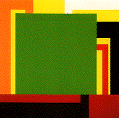
Peter Halley, 303, 1991, day-glo
acrylic, acrylic and Roll-A-Tex
on canvas, 88 1/2 x 91 1/2
inches, collection Cooperfund, Inc.

Peter Halley, A Perfect World, 1993, acrylic,
day-glo acrylic,
and Roll-a-Tex on canvas,
90 x 147 3/16 inches, Broad Art Foundation, Santa Monica, CA.

Jeff Koons (American, 1955-), Three Ball Total Equilibrium Tank (Two Dr. J.
Silver Series, Spalding NBA Tip-Off), 1985, mixed
media, 153.6 x 123.8 x 33.6 cm, Tate Gallery, London. See
readymade.
Jeff Koons, Rabbit, 1986, stainless steel, 41 x 19 x 12 inches, Broad Art Foundation, Santa Monica, CA. See sculpture.

Jeff Koons, Michael Jackson and Bubbles, 1988, ceramic, 42 x
70 1/2 x 32 1/2 inches, Broad Art Foundation, Santa Monica, CA.
See portrait.
Also see Minimalism.
Neo-Impressionism or neo-impressionism
Neolithic - The New (later) Stone Age.
Neo-Plasticism - Also called De Stijl. An art movement advocating pure abstraction and simplicity — form reduced to the rectangle, and color to the primary colors, along with black and white. Piet Mondrian (Dutch, 1872-1944) was the group's leading figure. He published a manifesto titled Neo-Plasticism in 1920. Another member of this movement, painter Theo van Doesberg (Dutch, 1883-1931) started a journal named De Stijl in 1917, which continued publication until 1928, spreading the theories of the group. It also included the painter George Vantongerloo (Belgian,1886-1965), and the architects J.J.P. Oud (1890-1963) and Gerrit Rietveld (Dutch, 1888-1965). Their work exerted tremendous influence on the Bauhaus and the International Style.
Examples:
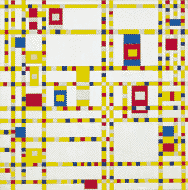
Piet Mondrian (Dutch, 1872-1944), Broadway Boogie Woogie. 1942-43, oil on canvas,
50 x 50 inches (127 x 127 cm), at the Museum of Modern Art, New
York. See grid and rhythm.
Theo van Doesburg (Dutch, 1883-1931), Tree, 1916, oil on panel, 26 x 22 inches (66 cm x 55.9 cm), Portland Art Museum, OR.

Theo van Doesburg (Dutch, 1883-1931),Composition X, 1918, oil
on canvas, 64 x 43 cm, Georges
Pompidou Center, Paris.
Georges Vantongerloo (Belgian, 1886-1965), Composition, 1917-1918, oil on canvas, 36 x 54 cm, Centre Georges Pompidou, Paris.
Also see geometric.
Netherlandish art - See Dutch art.
netsuke - In Japanese art, a belt toggle (literally "root for fastening"), often carved ivory or wood, and traditionally used to secure a purse or small container suspended on a silk cord from the sash of a kimono, because most kimono were without pockets. Introduced in the late 17th century, their heyday waned in the late 19th century, with the acceptance of Westernized styles of clothing. Netsuke represent a wide variety of subjects, with many in the form of animals, flowers, characters from religion, or mythology, No or Kabuki theater, usually no more than three inches high.
(pr. NET-sə-kee)
Examples:

Attributed to Gechu (Japanese), Baku, Monster Who Eats Nightmares, 18th
century, netsuke, ivory,
3 3/4 x 1 5/8 x 1 1/4 inches (9.5 x 3.1 x 4 cm), Los Angeles
County Museum of Art. See attributed.

Naito Toyomasa (Japanese), Netsuke, late 18th - mid-19th century,
wood, 3.3 x 3.1 cm, Hermitage Museum,
St. Petersburg, Russia.

Shokyusai Tomoyuki (Japanese), Netsuke Showing the Shaving of a Demon in the
Guise of a Monk, second half of the 19th century, ivory, 4.6 x 2.9 cm,
Edo School, Hermitage Museum, St. Petersburg, Russia.
Also see bibelot, costume, and sculpture.

neutral - A color not associated with a hue. Neutral colors include browns, blacks, grays, and whites. A hue can be neutralized by adding some of its complement to it.
(pr. NYOO-trəl or NOO-trəl)
new - Having been made or come into existence only a short time ago. And, perhaps: recent, or fresh, or not previously known, or different from the old, or rejuvenated, or original if it's the first one. Newness is a quality particularly highly prized by adherents to Modernism.
(pr. nyoo or noo)
Quotes:
Also see antiquarianism, antique, antiquing, antiquity, avant-garde, brainstorming, contemporary, creativity, derivative, derived image, iconogenetic, interesting, memory, modern, modernism, muse and muses, new media, postmodernism, and tradition.
newsprint - The type of paper on which newspapers are typically printed. This is a very inexpensive paper, manufactured from wood pulp, popular for use by students and for the making of sketches and preliminary drawings. It takes charcoal, soft lead pencil, and litho crayon well. Since it turns brown and becomes brittle on relatively short aging, it should not be considered for permanent work. Newsprint is available in pads, single sheets, and rolls.
New Wave cinema - A cinema style developed in the 1950s and 1960s that characteristically attempted to subvert viewer expecations by using ambiguity, surprise, fuzzy camera work, and abrupt changes in space, time, and mood. The French equivalent for this term is La Nouvelle Vague.
New York school - See Abstract Expressionism.
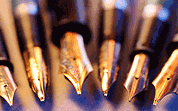 nib - The point
of a pen through which ink flows in order to make marks.
There are various shapes and
sizes commercially available
for drawing and writing (lettering,
calligraphy).
Each must fit into a handle. Nibs have most commonly been made
of metal, but have also been
made of quill (feather), reed,
bamboo, and plastics,
among other materials.
nib - The point
of a pen through which ink flows in order to make marks.
There are various shapes and
sizes commercially available
for drawing and writing (lettering,
calligraphy).
Each must fit into a handle. Nibs have most commonly been made
of metal, but have also been
made of quill (feather), reed,
bamboo, and plastics,
among other materials.
Also see India ink or Indian ink, and sepia ink.
![]()
nice - Pleasing, agreeable, or attractive in appearance, or courtesy and polite, or respectable, or subtle. So loosely positive a term as nice should be used as sparingly as possible.
Also see aesthetics, beauty, cute, description, kitsch, praise, and pretty.
![]()

niche - In architecture, an ornamental recess (concavity) in the thickness of a wall, especially for the display of a statue, bust, vase, or other erect ornament. Anything literally or figuratively resembling a niche. A niche is sometimes terminated by a cartouche, but more commonly by a canopy, and with a bracket or corbel for the figure, in which case it might be called a tabernacle. "Niche" is originally a French word. It was derived from Italian nicchio, meaning a shellfish or mussel, because many niches are more or less shell-like in form.
(pr. nitch or neesh)
Examples:

Iran, Mihrab
from the Madrasa Imami in Isfahan, 755 AH
/ c. 1354 CE,
mosaic of monochrome-glaze tiles
on composite body set on plaster,
11 feet 3 inches x 7 feet 6 inches (343.1 x 288.7 cm), Metropolitan
Museum of Art, NY. In Islamic
tradition, a large niche called
a mihrab is the most important
element inside of every mosque.
It indicates the direction of Mecca.

Michelangelo (born Michelangiolo Buonarroti)
(Italian, 1475-1564), Tomb of Giuliano de'Medici, 1526-1534,
marble, San Lorenzo, Cappella Medicea,
Florence. In the niche is the statue
of Giuliano Duke of Nemours who died in 1561. Below this, reclining
on Giuliano's sarcophagus,
are sculpture
of Night (Notte) and Day (Giorno). See Renaissance.

Jacques de Gheyn the Elder (Dutch, 1565-1629),
Vanitas Still Life, 1603, oil
on wood panel,
32 1/2 x 21 1/4 inches (82.6 x 54 cm), Metropolitan Museum of
Art, NY. See Dutch art, still life, and vanitas.

Gianlorenzo Bernini (Italian, 1598-1680), Trevi Fountain (Fontana di Trevi) (see two much closer and larger views: at night and at day), 1629-1762, Rome. This is the largest, most ambitious, and most famous of the great Baroque fountains of Rome. The allegorical theme of this sculptural ensemble is the taming of the waters. Tumbling about, water and stonework appear as a lively stage set, turning the small square that surrounds it into something like a theater. The fountain is set against the back of the Palazzo Poli, which was given a new facade of Corinthian columns that link the two main stories, and flank a triumphant arch with a large niche representing the palace of Neptune. In the central niche is Neptune, the sea god, riding a winged chariot guided by tritons through the gushing waters. Pope Urban VIII asked Bernini to design the fountain in 1629. Work on it was interrupted by the pope's death, but it was completed in 1762. It is called the Trevi because its position at the intersection of three streets -- tre vie. It is a frequently cited legend that if you throw a coin over your shoulder into the fountain, your return to Rome is guaranteed.
Related link:
Also see apse, arch, balcony, base, chapel, concave, diorama, dot, frame, pedestal, placement, plinth, Romanesque, shadow box, shaft grave, socle, and vitrine.
nichrome - A nickel-based alloy able to withstand high temperatures.
nickel - A silver-white, hard, malleable, barely ductile, rust-resistant metal, used mainly in alloys and for plating.
niello - A soft, black alloy of sulfur with copper (copper sulphide), gold (gold sulphide), silver (silver sulphide), or lead (lead sulphide), used to ornament metal objects. Designs incised on the objects are filled with the alloy (usually as a powder mixed with flux), which is then fused with the metal by application of heat. Also, to decorate using this process, or the objects decorated with it. Chiefly a late medieval and early Renaissance process.
(pr. nee-EL-oh)
Example:

Germany, Lower Saxony, c. 1160/70, Communion
Chalice, ("Wilten Chalice"), silver partially gilt,
with niello, height 16.7 cm,
Kunsthistoriches Museum, Venice. See chalice
and Romanesque.

Michel Witz the Younger (Austrian), Three-quarter
armor for a nobleman, made in Innsbruck c.1550, Steiermärkisches
Landesmuseum Joanneum, Graz, Austria. Michel Witz applied a niello
decoration all over this armor to achieve
a Baroque black and white design with grotesque
masks on shoulders,
elbows and knees, along with foliate
motifs everywhere else. In addition, the armor has been embossed
in part, a process whereby
the metal was hammered and
raised from within, producing
a relief on
the outside.
Also see electroplate and inlay.
night-blind and night blindness - Night blindness is nyctalopia, a reduced ability to see in faint light. English speakers have used this term since the 18th century, as an equivalent for the more scientifically technical term, "nyctalopia," in use since the 17th century. A person who is affectected by night blindness is night-blind.
Also see colorblind, crepuscular, dark, day for night, nocturne, perception, photoreceptors, retina, and tenebroso or tenebrism.
Nike - The ancient Greek goddess of victory, often identified with Athena, and by the Romans with Victoria. She is usually represented as a winged woman with windblown draperies.
The most famous representation of her:
Hellenistic Greece, Samothrace (island in the North Aegean Sea), c. 190 BCE, Nike on the Prow of a Ship, called the "Winged Victory of Samothrace", gray Lartos marble for the ship's prow, white Paros marble for the statue, height 3.28 m (floor to top of wings) (10 feet 9 inches), Louvre. See Hellenistic.
Also, a brand of sport apparel. . . (-: . . . See icon.
nimbus - A halo — a circle of radiant light around the heads of God, Christ, the Virgin Mary, or a saint. A type of aureole, gloriole, or glory. It indicates divinity or holiness, though originally it was placed around the heads of kings and gods as a mark of distinction.
Also see Gothic, Middle Ages, and votive.
Nirosta - A stainless steel trademark or brand name which applies to a variety of stainless steels that are produced by Krupp Thyssen Nirosta GmbH (KTN), which is headquartered in Krefeld, Germany. Since stainless steel is actually steel alloyed with chrome and nickel, the exact percentages of these ingredients are what is trademarked. The Nirosta trademark was registered in 1922 in Germany by Krupp. KTN is a part of the company Krupp Thyssen Stainless, which is in turn part of Thyssen Krupp Steel (under the Krupp Group). KTN is one of the world's leading producers of stainless steel. [This information contributed by David Semak, Clayton, CA.]
An example of a work in Nirosta:
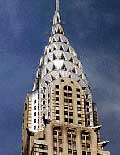
William Van Alen (American, 1882-1954), Chrysler
Building, 1930, New York City. An archetypal
American Art Deco
skyscraper, the exterior of the building reflects the Chrysler
automobile. The building was faced
with Nirosta stainless steel,
because of its low-maintenance, and the beauty of its color.
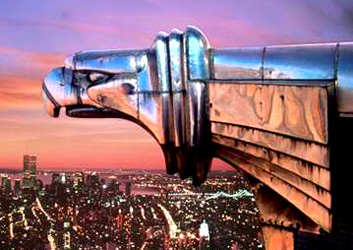 Part of the surface
decorations include sculptural
ornaments comparable to
Part of the surface
decorations include sculptural
ornaments comparable to gargoyles and hood ornaments.
The radiating curves on the building's dome
mimic giant sunbeams, a popular Art Deco theme.
nirvana - In Buddhism and Hinduism, a blissful state brought about by absorption of the individual soul or consciousness into the supreme spirit.
nise-e - In Japanese art, a portrait in sketchy outline. Also see mitsuda-e.
nishiki-e - In Japanese art, a polychrome print. Also see benizuri-e.
nitric acid - A mineral acid used as an oxidizing agent in etching. Also see aqua fortis.
nitrogen - A colorless, odorless, tasteless, inert, and non-explosive gas, N2, that is relatively inactive chemically; it occupies about 3/4 (by volume) of dry air. Its importance lies chiefly in its compounds, which include nitrous oxide, nitric acid, ammonia, fertilizers, proteins, etc. Tank sizes available: 20, 40, 80, 113, and 225 cubic feet. Atomic symbol N, atomic number 7.
Also see acetylene, argon, carbon dioxide, helium, hydrogen, and oxygen.
noise - In digital imaging, data or unidentifiable marks picked up in the course of scanning or data transfer that do not correspond to the original.
Also see chaos.
nomenclator and nomenclature - A book containing collections or lists of words. And one who gives names to or invents names for things. "Nomenclator" comes to us directly from Latin, in which it means "name caller" (from "nomen, meaning "name," and the verb "calare," meaning "to call"). In ancient Rome, the nomenclator's job was to call out the names of people as they approached a candidate during a political rally. His purpose may have been either to make the politician look good (as though he himself remembered everyone personally) or perhaps to apprise him of more names than he was ever expected to remember himself. In modern times the job title names one who creates new names for things. "Nomenclator" is applied especially to those who help create a "nomenclature" — a system of terms for a particular discipline.
(pr. NOH-mən-KLAY-tər and NOH-mə-CLAY-chər
) Also see lexicon, text, and title.

nonagon - A closed two-dimensional polygon bounded by nine straight-line segments. The formula with which to find an equilateral nonagon's area is 6.1818 times the length of one side squared.
Also see mathematics, radial, shape, and vertex.
nonferrous - Not composed of or containing iron. Nonferrous metals are often used in order to avoid iron's potential for rusting or magnetization.
nonobjective art - Artworks having no recognizable subject matter (not recognizable as such things as houses, trees, people, etc.) Also known as non-representational art.
Also see Abstract Expressionism, abstraction, abstract art, and aleatory and aleatoric, likeness, realism, and representation.
Northern and Southern Dynasties - A period of Chinese history which lasted from 310-589 CE.
Examples of work from this period:

China, Hebei province, Maitreya altarpiece, Northern Wei dynasty,
524 CE,
bronze with
gilding, height
30 1/4 inches (76.9 cm), Metropolitan Museum of Art, NY. See
altarpiece.

China, Shenxi Provence, Seated Bhuddha with Attending Bodhisattvas,
Northern Wei dynasty, early 6th century CE,
limestone with polychrome,
Worcester Art Museum, MA. See Bodhisattva
and Buddhist art.
Also see Northern and southern Song dynasties.
nostalgia - A bittersweet longing for things, persons, or
situations of the past. The condition of being homesick; homesickness. Those who are nostalgic are ![]()

![]() likely to favor traditions over the future's potential to be the site of better things. Everyone would like to escape the present for some qualities remembered from (or associated with) times past. Nostalgia is that yearning for whatever it is that makes the present less desirable. Modernists were the most thoroughly anti-nostalgic group of people, whereas postmodernists pursue newness without being embarrassed by their embrace of references to the past.
likely to favor traditions over the future's potential to be the site of better things. Everyone would like to escape the present for some qualities remembered from (or associated with) times past. Nostalgia is that yearning for whatever it is that makes the present less desirable. Modernists were the most thoroughly anti-nostalgic group of people, whereas postmodernists pursue newness without being embarrassed by their embrace of references to the past.
(pr. nahs-TAHL-jə)
Quote:
Also see camp, creativity, forget, kitsch, memorabilia, sentiment, sepia, xenophilia, and xenophobia.
nothing and nothingness -
Quote:
Also see conceptual art, negative space, and Zen.
nuance - A subtle difference, distinction, or variation; a subtle quality. Or a sensibility to, awareness of, or ability to express delicate gradations of a meaning (as of an attitude or expression) or of a form (as of its values, textures, or shades, tints, or tones of color, etc.) "Nuance" came to English in the late 18th century, having been "nubes" in Latin, then "nue" in Middle French, each meaning "cloud." In later French, "nue" developed into "nuer" meaning "to make shades of color."
(pr. NOO-ahns)
Also see brainstorming, creativity, irony, and letterform.
Nuit Américaine - See day for night.
numbered - Refers to labeling on a print of its place in the order of its production, when it is part of an edition of a limited quantity of impression.
Also see limited edition, multiple, and sequence.
nyctalopia - Night blindness. "Nyctalopia" comes to us from the Latin word "nyctalops," which means "suffering from night blindness." It is ultimately derived from the Greek word "nyktalops," which was formed by combining the word for "night" ("nyx") with the words for "blind" and "eye" ("alaos" and "ops," respectively). English speakers have been using "nyctalopia" to refer to reduced ability to see in faint light or at night since the 17th century; and have used the equivalent "night blindness" since the 18th century.
(pr. NIK-tə-LOH-pee-ə)
Also see crepuscular, day for night, nocturne, perception, photoreceptors, retina, and tenebroso or tenebrism.
nylon and Nylon ® - A type of polymer produced by a chemical process, capable of being pulled into fibers commonly made into such materials as fabrics and cords, which are noted for their strength and elasticity.
An example of a work made with nylon:
![]()

Jon Goldman (American), In a Lamprey's Mouth, 1986, inflatable
sculpture, computer-controlled interactive sound, nylon,
blower.
trademarks for nylon
|
trade name |
manufacturer, country |
| Maranyl ® | ICI, UK |
| Nylon ® | Du Pont, USA |
| Zytel ® | Du Pont, USA |
Also see acrylics, brush, cellulose, epoxy, plastics, polypropylene, polystyrene, polyurethane, polyvinyl chloride (PVC), resins, and trademark (®).
https://inform.quest/_art